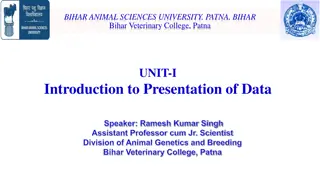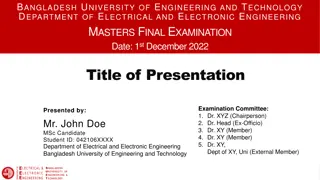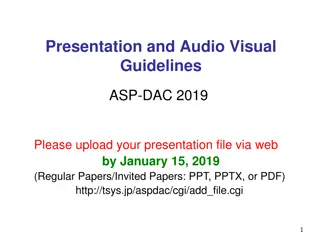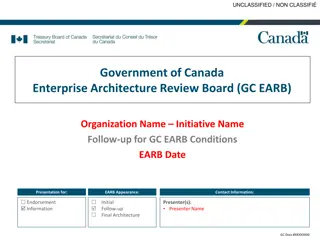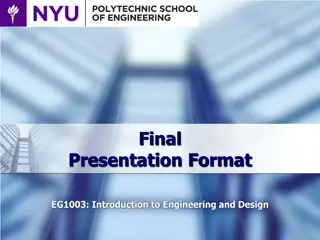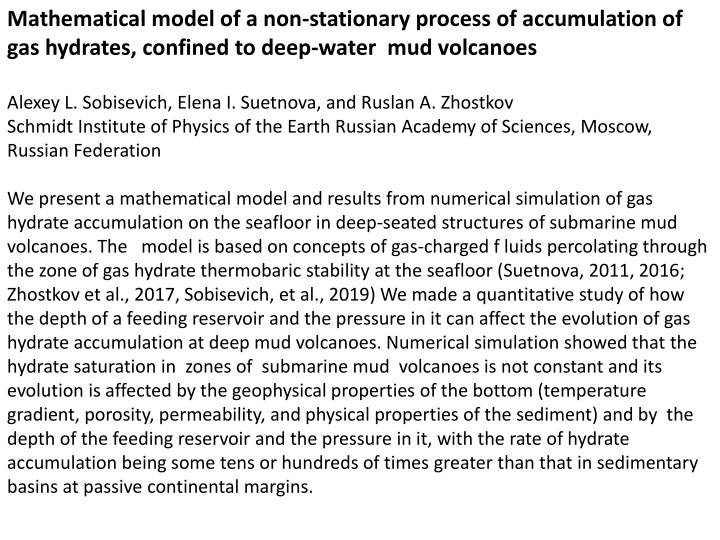
Mathematical Model of Gas Hydrate Accumulation in Deep-Water Mud Volcanoes
This study presents a mathematical model and numerical simulation of gas hydrate accumulation in deep-seated structures of submarine mud volcanoes. The model considers factors like depth of feeding reservoir, pressure, geophysical properties of the bottom, and more to analyze the evolution of hydrate accumulation. Results show significant accumulation rates compared to sedimentary basins, emphasizing the importance of quantitative models for understanding gas hydrate generation in deep mud volcanoes.
Download Presentation

Please find below an Image/Link to download the presentation.
The content on the website is provided AS IS for your information and personal use only. It may not be sold, licensed, or shared on other websites without obtaining consent from the author. If you encounter any issues during the download, it is possible that the publisher has removed the file from their server.
You are allowed to download the files provided on this website for personal or commercial use, subject to the condition that they are used lawfully. All files are the property of their respective owners.
The content on the website is provided AS IS for your information and personal use only. It may not be sold, licensed, or shared on other websites without obtaining consent from the author.
E N D
Presentation Transcript
Mathematical model of a non-stationary process of accumulation of gas hydrates, confined to deep-water mud volcanoes Alexey L. Sobisevich, Elena I. Suetnova, and Ruslan A. Zhostkov Schmidt Institute of Physics of the Earth Russian Academy of Sciences, Moscow, Russian Federation We present a mathematical model and results from numerical simulation of gas hydrate accumulation on the seafloor in deep-seated structures of submarine mud volcanoes. The model is based on concepts of gas-charged f luids percolating through the zone of gas hydrate thermobaric stability at the seafloor (Suetnova, 2011, 2016; Zhostkov et al., 2017, Sobisevich, et al., 2019) We made a quantitative study of how the depth of a feeding reservoir and the pressure in it can affect the evolution of gas hydrate accumulation at deep mud volcanoes. Numerical simulation showed that the hydrate saturation in zones of submarine mud volcanoes is not constant and its evolution is affected by the geophysical properties of the bottom (temperature gradient, porosity, permeability, and physical properties of the sediment) and by the depth of the feeding reservoir and the pressure in it, with the rate of hydrate accumulation being some tens or hundreds of times greater than that in sedimentary basins at passive continental margins.
Some estimates based on observations at the seafloor assume that the hydrate saturation of the seafloor in the range of PT stability for gas hydrates that is associated with mud volcanism is approximately 25% (Milkov et al., 2003; Ginsburg and Soloviev, 1997). These estimates were derived by extrapolating the surface values downward without considering possible evolution of hydrate accumulations due to mud volcanic processes (Feseker et al., 2014), which affects the geophysical conditions at the seafloor in zones of mud volcanoes. Considering that subaqueous mud volcanoes and the gas hydrate accumulations that are confined to these are important for studies of geological hazards, climate change, estimation of terrestrial degassing, etc., one needs to develop, not only merely qualitative, but also quantitative models for the generation and evolution of gas hydrates in zones of deep mud volcanoes. This study presents a mathematic model for the accumulation of gas hydrates that are confined to submarine mud volcanoes and shows results from simulation to derive rates of accumulation for gas hydrates and for their evolution under different possible values of geophysical parameters in the occurrence of mud volcanism.
THE MATHEMATICAL MODEL The present mathematical model for the accumulation of gas hydrates that are confined to deep-sea mud volcanoes is based on concepts of gas-charged fluids percolating through the zone of gas hydrate thermobaric stability at the seafloor (Suetnova, 2011, 2016; Zhostkov et al., 2017; Sobisevich, 2019) and on information concerning the percolation of gas-charged fluids toward the seafloor in zones of mud volcanoes. The mathematical model proposed here describes the complex process of gas hydrates that are being accumulated in the zone of their thermobaric stability from the gas-saturated porous fluid that is percolating around the vent above the feeding reservoir where the saturating fluids are under a high pressure. The mathematical model of this complex process consists in equations in partial derivatives (1 5) (Suetnova, 2016; Zhostkov et al., 2017) with appropriate boundary conditions:
Figure 1 presents results from a simulation of the evolution of hydrate saturation during 10 or 50 years from the start of percolation for a permeability coefficient k0= 10 14m2and a sediment thickness above the feeding layer L = 500 or 1000 m for an external pres- sure of 12 MPa (sea depth around 1200 m), 83% or 100% of the lithostatic pressure in the reservoir and a theoretical depth of 350 m to the zone where gas hydrates are stable, with the other parameters being m0= 0.3, = 2.6 10 3Pa s, f= 1.0 103kg/m3, s= 2.65 103 kg/m3, = 1010, ch= 0.12, and the background temperature gradient equal to 0.05 K/m (Davie et al., 2004; Rempel and Buffett, 1997; Fig. 1. The evolution of hydrate saturation. (a) for 50 years, L = 1000 m, the pressure in the reservoir is lithostatic; (c) for 10 years, L = 500 m, the pressure in the reservoir is lithostatic; (b) for 50 years, L = 1000 m, the pressure in the reservoir is 83% of the lithostatic value; (d) for 10 years, L = 500 m, the pressure in the reservoir is 83% of the lithostatic value.




